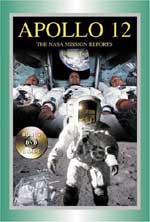
The Apollo 12 mission landed the second set of crewmen onto the moon. After the success of Apollo 11, the attitude had swung a bit from ‘can we make it’ to ‘what’s the best we can do’. The lunar orbit insertion technique changed, the landing had a distinct target (i.e. near Surveyor 3), and expectations for exploration and assessment were more detailed and grander. If everything else remained the same, this might be considered a trivial advance. But space travel was still new and with the complex and tightly coupled systems involved, something always sprang up. Godwin, in his compilation, provides the official view of many of these occurrences.
The book is loosely divided into three sections. The first examines the expectations and the operations, the second examines the equipment and experiments, while the third looks at equipment anomalies. The expectations centre about the men’s activity on the surface, the geological examination, scientific experiments and their own mobility. Coarse maps and photographs show routes and setups for surface equipment. The operations description describes the descent in some detail, including charts of altitude, pitch, yaw and roll as a function of time. In fact, by continually using a time reference, Godwin provides an excellent metric to keep tabs of what’s happening..
Seeing as this is an official report, it is not surprising that the next section gives much more attention to the equipment and experiments rather than crew activities. Descriptions portray the purpose and composition of most of the experiments. Direct results are listed, such as identifying the number of rolls of film successfully taken. Charts show seismic output. Some of the equipment is profiled. The included pilot’s report gives the precise bureaucratic description of events from launch through to landing back on earth. A simple strip chart lists major events opposite ground elapsed time to permit quick review of activities. Suffice it to say that Apollo12’s mission objectives were almost all completed satisfactorily, that is, the equipment and experiments did what they needed to do.
One of the more interesting parts of this compilation is the review of the anomalies. Imagine sitting on more than 5 million pounds of propellent and then being struck twice by lightening as they were! No serious consequences ensued similarly with other less exciting anomalies. Filters backed up, valves stuck, electronics failed, just like the operation of any large piece of machinery. Perhaps what is more revealing is the small quantity of anomalies. To clarify each, the book provides a point by point description of the anomaly, the resolution and any subsequent action.
Upon reading this book, two powerful messages clearly jump out. The first is the overall complexity of the mission. With help being five days away at best, reliability was critical so care had to be taken and it is a wonder that things went as smoothly as they did. This may account for the pedantic nature of the operations and the dry tone of the reports in the book. The second message is that lessons were learned and actions taken; after all this was the 12th Apollo mission; the second that landed. However, where are these lessons now? Are they only in books like this and dusty government repositories? These unasked questions arise but no answers are present.
Fine as this book is, don’t forget its source, bureaucracy. Dry yes, but to liven your day just watch the included DVD. Astronauts rejoice on landing, sing while collecting geological samples and smile broadly while resting in quarantine. The live video pictures the launch from many angles, the lunar landing, many of the astronaut’s activities on the surface, the rendezvous and the recovery of the crew and capsule after splash down. This double sided disc gives many hours to recreate the mood and feeling of this great event.
What is missing from this book is any discussion, in particular where is the information on the importance of the mission and its objectives. Further, and more important, as most of the book focuses on the anomalies, the consequence of failure should have been added. Did the lightening strikes pose much of a danger? Did the mission ever come close to a hazardous situation and to what consequence? Taking the opportunity to add this perspective would have made this rich book more rewarding.
Von Braun’s vision of the lunar missions was as a stepping stone to bigger and better things. Robert Godwin’s compilation in ‘Apollo 12 The NASA Mission Reports, Volume Two‘ provides an excellently edited selection of the milestones that Apollo 12 achieved and the glitches that made its journey interesting. As a combination, the dry tone of the book and the lively feel of the included DVD make for an entertaining and informative reference for this lunar mission.
To get your own copy, visit Amazon.com.
Review by Mark Mortimer
